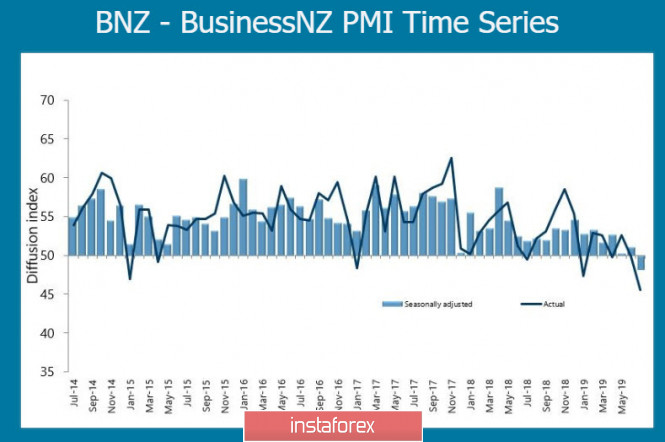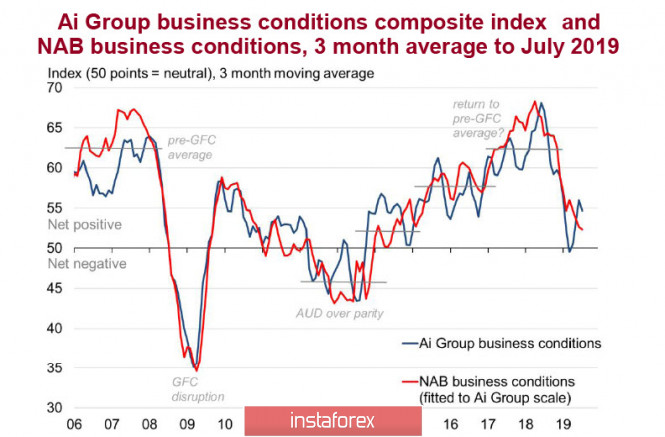On Monday, stock indices are growing steadily on the news from China. Last Saturday, the People's Bank of China made a crucial decision to reform the assessment of the key interest rate, which increases expectations for easing monetary policy and is expected to contribute to the increase in risk appetite.
As a result, protective assets are sold, gold goes into correction after rapid growth, and rates on government bonds are growing rapidly. Although it is not yet clear how long the positive attitude will last, but in the short term, it is necessary to proceed from the fact that raw materials and risky assets will be in demand.
NZDUSD
The manufacturing sector of New Zealand fell for the first time since 2012.The PMI index in July amounted to 48.2 p. against 51.1 p a month earlier. On the other hand, the sub index of new orders also fell to a minimum in almost 7 years, and employment reached its lowest level since June 2009.

These data could be a cause of serious concern to the RBNZ, however, there is one positive point that has so far offset the deterioration in the manufacturing sector. This factor is the increase in average wages. Despite the obvious problems with economic growth, the average hourly earnings in the sector amounted to 2 sq. 4.5%, and annual inflation rose from 2.1% to 2.2%.
These figures allow us to hope that domestic demand is still at a high level, and therefore, the RBNZ will continue to hold a pause in interest rates until the end of the year. At the same time, in the long run, the trend is negative and is based on a change in the demographic composition of the population of New Zealand. According to the ANZ study, the ratio of the working population of New Zealand to the disabled will decrease by 25% in the coming years, so the RBNZ fiscal policy will be directed towards continuing mitigation, even if the economy shows signs of recovery.
In the short term, New Zealand will continue to trade in the range with a gradual drift to the support level of 0.6377. Possible growth in the resistance zone 0.6433 / 50 can be used for sales, while stops are above 0.6470.
AUDUSD
Australian currency continues to trade in the range. Macroeconomic data, which was published last week, did not significantly affect quotes. The consumer confidence index from Westpac rose in August to + 3.6 p from -4.1 p a month earlier. This is a good sign of stable demand, respectively, increased inflation expectations. Meanwhile, monthly calculated by the University of Melbourne, increased, while unemployment remained unchanged at 5.2% in July.
Ai Group's composite business conditions index and NAB's business conditions index still look very unconvincing. Thus, the downward trend continues.

The conditions for continuing the mitigation policy from the RBA continues. Inflation forecast remains negative. NAB suggests that by the end of 2021, inflation will reach the bottom of the target range. GDP growth over the next two years is projected at a level slightly above 2%, which is not bad against the background of global trends. However, it is considered very little if you look at internal historical data. Analysts are most worried about the weak sustainability of households, the decline in business investment, and the decline in exports.
In addition, the threat of further rate cuts remains. So far, the consensus opinion of the market is that another reduction will occur in November. The rate will be lowered to 0.75%, while other measures are not excluded. More and more opinions are increasingly being published that, in addition to the RBA policy, the government should be involved in solving the problem of economic slowdown, for which it must introduce new tax incentives in order to maintain consumer demand and investment in infrastructure, since the state of the balance sheet allows such steps to be taken without any special consequences budget.
In conclusion, the Australian currency will remain in the range in the short-term in the near future, but the downward trend will increase. The nearest support at 0.6760 / 70 will not last long, the movement to 0.6734 will continue, and the breakthrough of support may strengthen the downward momentum.
The material has been provided by InstaForex Company - www.instaforex.com